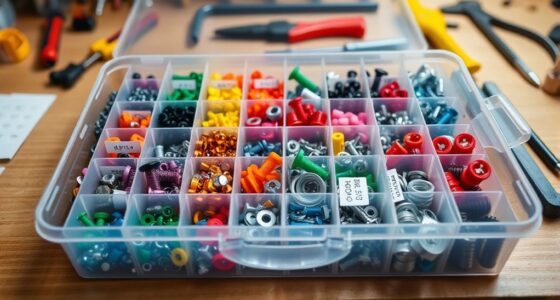Building a mobile workshop cart helps you stay organized, maximize workspace flexibility, and improve efficiency. Start by choosing durable materials like plywood or metal, then design compartments, drawers, and shelves for easy access and safety. Select sturdy, lockable casters to keep it mobile and secure. Pay attention to handles and reinforcement for long-lasting durability. If you keep exploring, you’ll discover detailed tips to make your cart both functional and easy to build.
Key Takeaways
- Plan the layout with drawers, shelves, and compartments for organized access to tools and materials.
- Select durable materials like plywood or metal and securely attach sturdy, lockable wheels for mobility.
- Incorporate safety features such as lip edges on shelves and reinforced structures for long-term durability.
- Add labels, hooks, and grouping systems to improve quick identification and access of stored tools.
- Ensure ergonomic handles and wheel placement for smooth movement and stability during use and transport.

Creating a mobile workshop cart is a practical way to organize your tools and materials while increasing your workspace flexibility. When you build your own cart, you gain a customized solution that fits your specific needs, making it easier to access what you need without wasting time searching through clutter. The key to a successful project lies in designing a sturdy, functional piece that offers effective tool storage and seamless mobility. Think about the types of tools you use most frequently and how best to store them. Incorporate drawers, bins, or shelves to keep everything visible and within reach. Using different compartments helps prevent tools from bouncing around during movement and keeps your workspace tidy. You’ll find that a well-organized cart not only improves efficiency but also reduces the risk of losing or damaging tools.
A well-organized mobile workshop cart enhances efficiency and keeps tools accessible and secure during work.
Mobility solutions are at the heart of this project. Your goal should be to create a cart that’s easy to move around your workshop, whether you’re shifting it across the room or taking it outside for a project. To achieve this, select durable wheels or casters that can handle the weight and are easy to roll over different surfaces. Locking casters are a smart choice for stability when working in one spot, while swivel wheels make navigation smoother. Consider the weight of your tools and materials when choosing your wheels; heavier-duty options are often necessary for larger, more robust carts. Additionally, think about the handle design—placing handles at strategic points will make pushing or pulling your cart effortless and ergonomic.
When building your cart, pay close attention to the materials you use. Plywood or metal frames provide strength and durability, ensuring your cart can withstand daily wear and tear. You might also want to reinforce shelves or add lip edges to prevent tools from falling off during movement. Securing the wheels properly to the frame is *essential* for safety and stability. Once assembled, customize your tool storage solutions by grouping similar tools together, labeling compartments, or adding hooks for quick access. This not only enhances organization but also speeds up your workflow.
Including safe and reliable components such as high-quality wheels and sturdy frames will ensure your cart remains functional and secure over time. In the end, a well-designed mobile workshop cart provides a flexible, organized workspace that adapts to your projects. By focusing on quality tool storage and reliable mobility solutions, you’ll create a system that keeps your tools accessible and your workspace efficient. Building this cart is a rewarding project that yields long-term benefits, making your time in the workshop more productive and enjoyable.
Frequently Asked Questions
What Materials Are Best for Weatherproofing the Cart?
You should use weatherproof coatings like marine-grade paint or sealant to protect your cart from moisture. Applying waterproof seals around joints, edges, and fittings prevents water from seeping in. Make sure to choose durable, outdoor-rated materials that resist rust and decay. Regularly reapply coatings and seals to maintain protection, especially if you frequently move your cart outdoors or in harsh weather conditions.
How Do I Customize Storage for Specific Tools?
You can customize your tool storage by adding drawers, shelves, or pegboards tailored to your specific tools. Use customization options like adjustable dividers and labeled compartments to keep everything organized and easily accessible. Consider installing removable bins for larger items or specialty holders for power tools. By personalizing your storage setup, you guarantee your tools stay secure and organized, making your mobile workshop more efficient and user-friendly.
What Safety Precautions Should I Consider During Assembly?
When assembling your mobile workshop cart, always wear personal protective equipment like safety glasses and gloves to prevent injuries. Make certain all parts are securely fastened, using proper tools to avoid loose connections that could cause accidents. Work in a well-lit area and keep your workspace tidy to prevent trips or falls. Double-check all fastenings and stability before moving the cart, prioritizing safety throughout the entire assembly process.
How Can I Improve the Cart’s Mobility on Uneven Surfaces?
Sure, because your cart’s wheel setup is clearly the reason it’s stuck in the mud, right? To fix that, upgrade your wheels with larger, more rugged options and add surface grips for better traction. These upgrades help your cart glide smoothly over uneven surfaces, saving your back and sanity. With stronger wheels and better grips, your mobile workshop becomes a true ninja, conquering rough terrain with ease.
What Maintenance Is Required to Keep the Cart in Good Condition?
You should follow a regular lubrication schedule to keep all moving parts functioning smoothly and prevent squeaks. Check wheels and axles frequently, applying grease as needed. To prevent rust, clean the cart after use, especially if exposed to moisture, and consider applying a rust prevention spray or paint. Regular inspections and maintenance will extend your cart’s lifespan and keep it in top condition for years to come.
Conclusion
So, there you have it—your shiny new mobile workshop cart ready to roll, conquer, and maybe even impress your neighbors. Now, every tool has a home, and your garage finally looks organized enough to host a royal visit. Just remember, with great mobility comes great responsibility—don’t let it wander off into the sunset without you. Happy building, and may your workshop always be as tidy as your cart’s new wheels!








